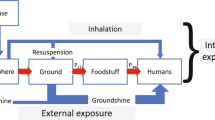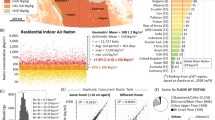Abstract
Exposure to ionizing radiation of cosmic origin is an occupational risk factor in commercial aircrew. In a historic cohort of 26,774 German aircrew, radiation exposure was previously estimated only for cockpit crew using a job-exposure matrix (JEM). Here, a new method for retrospectively estimating cabin crew dose is developed. The German Federal Radiation Registry (SSR) documents individual monthly effective doses for all aircrew. SSR-provided doses on 12,941 aircrew from 2004 to 2015 were used to model cabin crew dose as a function of age, sex, job category, solar activity, and male pilots' dose; the mean annual effective dose was 2.25 mSv (range 0.01–6.39 mSv). In addition to an inverse association with solar activity, exposure followed age- and sex-dependent patterns related to individual career development and life phases. JEM-derived annual cockpit crew doses agreed with SSR-provided doses for 2004 (correlation 0.90, 0.40 mSv root mean squared error), while the estimated average annual effective dose for cabin crew had a prediction error of 0.16 mSv, equaling 7.2% of average annual dose. Past average annual cabin crew dose can be modeled by exploiting systematic external influences as well as individual behavioral determinants of radiation exposure, thereby enabling future dose–response analyses of the full aircrew cohort including measurement error information.
This is a preview of subscription content, access via your institution
Access options
Subscribe to this journal
Receive 6 print issues and online access
$259.00 per year
only $43.17 per issue
Buy this article
- Purchase on Springer Link
- Instant access to full article PDF
Prices may be subject to local taxes which are calculated during checkout



Similar content being viewed by others
References
Zeeb H, Hammer GP, Blettner M . Epidemiological investigations of aircrew: an occupational group with low-level cosmic radiation exposure. J Radiol Prot 2012; 32: N15–N19.
Trugenberger-Schnabel A, Löbke-Reinl A, Peter J . Umweltradioaktivität und Strahlenbelastung - Jahresbericht 2014 (in German). Bundesamt für Strahlenschutz: Salzgitter, Germany, 2016. Available at: http://nbn-resolving.de/urn:nbn:de:0221-2016091514109.
Blettner M, Zeeb H, Langner I, Hammer GP, Schafft T . Mortality from cancer and other causes among airline cabin attendants in Germany, 1960-1997. Am J Epidemiol 2002; 156: 556–565.
Zeeb H, Blettner M, Hammer GP, Langner I . Cohort mortality study of German cockpit crew, 1960-1997. Epidemiology 2002; 13: 693–699.
Zeeb H, Langner I, Blettner M . Cardiovascular mortality of cockpit crew in Germany: cohort study. Z Kardiol 2003; 92: 483–489.
Zeeb H, Hammer GP, Langner I, Schafft T, Bennack S, Blettner M . Cancer mortality among German aircrew: second follow-up. Radiat Environ Biophys 2010; 49: 187–194.
Hammer GP, Blettner M, Langner I, Zeeb H . Cosmic radiation and mortality from cancer among male German airline pilots: extended cohort follow-up. Eur J Epidemiol 2012; 27: 419–429.
Blettner M, Zeeb H, Auvinen A, Ballard TJ, Caldora M, Eliasch H et al. Mortality from cancer and other causes among male airline cockpit crew in Europe. Int J Cancer 2003; 106: 946–952.
Zeeb H, Blettner M, Langner I, Hammer GP, Ballard TJ, Santaquilani M et al. Mortality from cancer and other causes among airline cabin attendants in Europe: a collaborative cohort study in eight countries. Am J Epidemiol 2003; 158: 35–46.
Langner I, Blettner M, Gundestrup M, Storm H, Aspholm R, Auvinen A et al. Cosmic radiation and cancer mortality among airline pilots: results from a European cohort study (ESCAPE). Radiat Environ Biophys 2004; 42: 247–256.
Hammer GP, Auvinen A, de Stavola BL, Grajewski B, Gundestrup M, Haldorsen T et al. Mortality from cancer and other causes in commercial airline crews: a joint analysis of cohorts from 10 countries. Occup Environ Med 2014; 71: 313–322.
Hammer GP, Zeeb H, Tveten U, Blettner M . Comparing different methods of estimating cosmic radiation exposure of airline personnel. Radiat Environ Biophys 2000; 39: 227–231.
UNSCEAR- United Nations Scientific Committee on the Effects of Atomic Radiation, UNSCEAR 2006 Report. Effects of ionizing radiation, Volume I. United Nations: New York, NY, USA, 2008.
Lewis BJ, McCall MJ, Green AR, Bennett LG, Pierre M, Schrewe UJ et al. Aircrew exposure from cosmic radiation on commercial airline routes. Radiat Prot Dosimetry 2001; 93: 293–314.
O'Brien K, Smart DF, Shea MA, Felsberger E, Schrewe U, Friedberg W et al. World-wide radiation dosage calculations for air crew members. Adv Space Res 2003; 31: 835–840.
Lindborg L, Bartlett D, Beck P, McAulay I, Schnuer K, Schraube G et al. EURADOS. Cosmic Radiation Exposure of Aircraft Crew: Compilation of Measured and Calculated Data. European Commission, Office for Official Publication of the European Communities: Luxembourg, Belgium. 2004.
Mares V, Maczka T, Leuthold G, Ruhm W . Air crew dosimetry with a new version of EPCARD. Radiat Prot Dosimetry 2009; 136: 262–266.
Goldhagen P . Overview of aircraft radiation exposure and recent ER-2 measurements. Health Phys 2000; 79: 526–544.
Kákona M, Ploc O, Kyselová D, Kubancák J, Langer R, Kudela K . Investigation on contribution of neutron monitor data to estimation of aviation doses. Life Sci Space Res 11: 24–28.
Tobiska WK, Bouwer D, Smart D, Shea M, Bailey J, Didkovsky L et al. Global real-time dose measurements using the Automated Radiation Measurements for Aerospace Safety (ARMAS) system. Space Weather 2016; 14: 1053–1080.
U.S. Federal Aviation Administration (FAA). Heliocentric potential. Available at: https://www.faa.gov/data_research/research/med_humanfacs/aeromedical/radiobiology/heliocentric/. (accessed 05 April 2017.)
Frasch G, Kammerer L, Karofsky R, Schlosser A, Spiesl J, Stegemann . Die berufliche Strahlenexposition des fliegenden Personals in Deutschland 2004-2009. Report of the German federal radiation protection register [in German]. Bundesamt für Strahlenschutz: Salzgitter, Germany, 2011. Available at: http://nbn-resolving.de/urn:nbn:de:0221-201108016029.
Kim J-H . Estimating classification error rate: repeated cross-validation, repeated hold-out and bootstrap. Comp Stat Data Anal 2009; 53: 3735–3745.
Molinaro AM, Simon R, Pfeiffer RM . Prediction error estimation: a comparison of resampling methods. Bioinformatics 2005; 21: 3301–3307.
R Development Core Team R: A Language and Environment for Statistical Computing. R Foundation for Statistical Computing: Vienna, Austria. 2016.
Winter M, Blettner M, Zeeb H . Prevalence of risk factors for breast cancer in German airline cabin crew: a cross-sectional study. J Occup Med Toxicol 2014; 9: 27.
Talibov M, Salmelin R, Lehtinen-Jacks S, Auvinen A . Estimation of occupational cosmic radiation exposure among airline personnel: agreement between a Job-Exposure Matrix, aggregate, and individual dose estimates. Am J Ind Med 2017; 60: 386–393.
Allodji RS, Schwartz B, Diallo I, Agbovond C, Laurier D, de Vathaire F . Simulation-extrapolation method to address errors in atomic bomb survivor dosimetry on solid cancer and leukaemia mortality risk estimates, 1950-2003. Radiat Environ Biophys 2015; 54: 273–283.
Carroll RC, Ruppert D, Stefanski LA, Crainiceanu CM Measurement Error in Nonlinear Models: A Modern Perspective, 2nd edn, Chapman Hall/CRC: Boca Raton, FL, USA, 2006..
Ozasa K, Shimizu Y, Suyama A, Kasagi F, Soda M, Grant EJ et al. Studies of the mortality of atomic bomb survivors, report 14, 1950-2003: an overview of cancer and noncancer diseases. Radiat Res 2012; 177: 229–243.
Pierce DA, Stram DO, Vaeth M . Allowing for random errors in radiation dose estimates for the atomic bomb survivor data. Radiat Res 1990; 123: 275–284.
Pierce DA, Vaeth M, Cologne JB . Allowance for random dose estimation errors in atomic bomb survivor studies: a revision. Radiat Res 2008; 170: 118–126.
Darby S, Hill D, Doll R . Radon: a likely carcinogen at all exposures. Ann Oncol 2001; 12: 1341–1351.
Brenner DH . Effective dose: a flawed concept that could and should be replaced. Br J Radiol 2008; 81: 521–523.
Schrewe UJ . Global measurements of the radiation exposure of civil air crew from 1997 to 1999. Radiat Prot Dosimetry 2000; 91: 347–364.
Wissmann F . Long-term measurements of H*(10) at aviation altitudes in the northern hemisphere. Radiat Prot Dosimetry 2006; 121: 347–357.
Kojo K, Helminen M, Leuthold G, Aspholm R, Auvinen A . Estimating the cosmic radiation dose for a cabin crew with flight timetables. J Occup Environ Med 2007; 49: 540–545.
Acknowledgements
This work was funded by the employers' mandatory liability insurance Berufsgenossenschaft Verkehrswirtschaft Post-Logistik Telekommunikation (BG Verkehr). We thank Deutsche Lufthansa AG and Air Berlin for providing support as well as data access. We thank the Federal Office for Radiation Protection and specifically the staff of the German Federal Radiation Registry for their efforts and support in providing dose registry data for the cohort. The third follow-up was approved by the ethics committee of the Bremen Medical Association. The requirement to seek informed consent from individual cohort members was waived.
Author information
Authors and Affiliations
Corresponding author
Ethics declarations
Competing interests
The authors declare no conflict of interest.
Additional information
Supplementary Information accompanies the paper on the Journal of Exposure Science and Environmental Epidemiology website
Supplementary information
Rights and permissions
About this article
Cite this article
Wollschläger, D., Hammer, G., Schafft, T. et al. Estimated radiation exposure of German commercial airline cabin crew in the years 1960–2003 modeled using dose registry data for 2004–2015. J Expo Sci Environ Epidemiol 28, 275–280 (2018). https://doi.org/10.1038/jes.2017.21
Received:
Accepted:
Published:
Issue Date:
DOI: https://doi.org/10.1038/jes.2017.21



